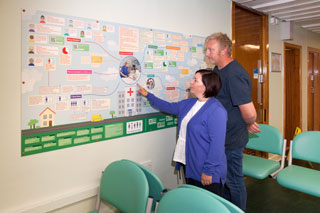Dr Lee Cutler, a Critical Care Consultant Nurse from Doncaster and Bassetlaw Teaching Hospitals knows firsthand the impact that critical illness has on patients and their relatives – and has come up with an innovative way to help explain the process to them. We asked Lee to tell us more:

The critical illness roadmap in use
‘Critical illness can be a devastating, frightening and debilitating condition for patients and harrowing for their loved ones. Many patients in critical care die. As healthcare professionals we are rarely shocked by this – we have seen it so many times. But for families they often think we can do miracles. Of those who do survive – the recovery can be very protracted and difficult. Even when patient return home – they can face months or years of after-effects and many never fully recover or regain their former function and quality of life.
Healthcare professionals are faced with the daily challenge of giving useful information to service users. But frightened and anxious families need just the right amount and format of information. It helps them anticipate what is around the next corner and cope with the ‘then’ and ‘now’ of their experience. They have so many questions and struggle to understand and retain what we tell them. As an expert critical care nurse and service lead I have been a long term observer of the challenges faced by both service users and staff. I came to the conclusion that we needed to try a new approach to giving information to critical care families.
What did we aim to do?
We wanted to provide a very comprehensive information source in the visitors area so that families could read it at their convenience – returning to it when they wanted to. We also wanted to signpost to other sources of information. How did we decide what information to include in the poster? It was important to involve families and patients in helping us decide what information to include. We have a critical care support group where ex-patients and their families come together to support each other and work through their journey of recovery. In one particular session we dedicated the whole meeting to writing ideas on sticky notes and pasting then on a draft poster.
It was also important to review the important research that has been published about the whole journey through critical illness and recovery. We read the key studies and attempted to narrow the vast range of information and statistics available into the key headlines we thought families should know.
We shared a draft of the poster with multidisciplinary staff in our critical care unit and also at a further meeting of the critical care support group. This allowed us to make the final changes and complete the poster.
How was the poster designed?
We commissioned Ben, a talented designer with skills in presenting user-friendly graphical information. We spent many days rearranging the content using specialist software.
We couldn’t add all the information we wanted so we decided to use QR codes to direct people to other sources of information – such as websites, on-line booklets and support groups.
The final version of the poster was approved by the critical care clinical governance group and the ‘information for service users’ group within the Trust.
Where is it now?
The poster was completed in June 2018. It is now displayed in the visitors waiting area in our critical care unit.
View the poster in PDF format.
Who else is displaying the poster in the NHS?
Staff from other critical care units who knew we were designing the poster asked for a copy. So we decided to share it throughout the NHS via the Critical Care National Network Nurse Leads group (CC3N). That lead to many enquiries from throughout the NHS.
For a small fee our designer agreed to change the logo on the poster for any units that wanted their own version. Over 50 critical care units in the NHS have so far adopted the poster and others have commissioned an adapted version or asked for modifications so that it suits their local needs.
What do visitors to our unit think of the poster?
All feedback so far has been positive. Families have obviously spent time reading and re-reading the poster. Staff also find that the information in the poster helps them reinforce key messages and direct families to other resources.
Anyone – the only cost is to add the logo of the organisation using the poster. If anyone would like a digital copy or wants to discuss adapting it – please email our designer Ben.’
For any further information about the poster, contact Dr Lee Cutler.